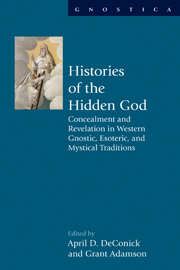 Histories of the Hidden God
Histories of the Hidden God Book contents
- Frontmatter
- Contents
- Acknowledgments
- Contributors
- Introduction: In search of the hidden God
- Part I Concealment of the Hidden God
- Part II The Human Quest for the Hidden God
- Part III Revelations of the Hidden God
- 11 Revealing and concealing God in ancient synagogue art
- 12 The invisible Christian God in Christian art
- 13 On the Mothman, God, and other monsters: The demonology of John A. Keel
- 14 Hidden away: Esotericism and Gnosticism in Elijah Muhammad's Nation of Islam
- 15 Conscious concealment: The repression and expression of African American Spiritualists
- 16 Occulture in the academy? The case of Joseph P. Farrell
- Afterword: Mysticism, Gnosticism, and esotericism as entangled discourses
- Bibliography
- Index
13 - On the Mothman, God, and other monsters: The demonology of John A. Keel
from Part III - Revelations of the Hidden God
- Frontmatter
- Contents
- Acknowledgments
- Contributors
- Introduction: In search of the hidden God
- Part I Concealment of the Hidden God
- Part II The Human Quest for the Hidden God
- Part III Revelations of the Hidden God
- 11 Revealing and concealing God in ancient synagogue art
- 12 The invisible Christian God in Christian art
- 13 On the Mothman, God, and other monsters: The demonology of John A. Keel
- 14 Hidden away: Esotericism and Gnosticism in Elijah Muhammad's Nation of Islam
- 15 Conscious concealment: The repression and expression of African American Spiritualists
- 16 Occulture in the academy? The case of Joseph P. Farrell
- Afterword: Mysticism, Gnosticism, and esotericism as entangled discourses
- Bibliography
- Index
Summary
Monsters are in the world but not of the world. They are paradoxical personifications of otherness within sameness. That is, they are threatening figures of anomaly within the well-established and accepted order of things. They represent the outside that has gotten inside, the beyond-the-pale that, much to our horror, has gotten into the pale.
Timothy K. Beal, Religion and Its MonstersWhat is a monster? A being whose duration is incompatible with the existing order.
Diderot, Elements of PhysiologyHoustonians, myself included, are very proud of the fact that Houston was the first word spoken on the surface of the moon, by Apollo 11 astronaut Neil Armstrong, on July 20, 1969, to be precise: “Houston, Tranquility Base here, the Eagle has landed.” NASA is just down the road from where I sit and write, in Clear Lake. Our professional baseball team is called the Astros, our basketball team the Rockets. In the present essay, I would like to extend this local space culture (“the outside that has gotten inside”) and explore a few of the very extensive ways that pulp fiction, science fiction, and the cold war space race have entered modern occultism and a contemporary living mythology that I have been tracing through a two-volume study of the paranormal and American popular culture. More specifically, I would like to dwell here on a writer that I could only summarize there, the American journalist, UFO specialist, monster hunter, and self-described demonologist John A. Keel.
- Type
- Chapter
- Information
- Histories of the Hidden GodConcealment and Revelation in Western Gnostic, Esoteric, and Mystical Traditions, pp. 234 - 258Publisher: Acumen PublishingPrint publication year: 2013


